Now that the business world is changing rapidly, organizations see that managing the workforce effectively is very important. With digital transformation, managing employees has changed a lot, so employee management software is now essential for companies. What began as basic payroll software has grown into an all-around solution that simplifies all HR-related tasks.
In today’s world, more and more businesses look for workforce software that brings together different areas, is comfortable to use, and can expand with their needs. Businesses are interested in finding ways to handle recruiting, onboarding, performance measurements, and encouraging employees. Effective employee management software allows businesses to work better, reduces paperwork, and boosts how staff feel at work.
In 2025, the market will be filled with solutions that were designed to meet various organizational problems. We’ve included 10 leading platforms in this guide that are breaking new ground for workforce management, helping companies pick the best HR tech solutions.
What is Employee Management Software?
A digital tool called employee management software can help an organization handle and automate all kinds of HR tasks. Businesses depend on these platforms to handle all aspects of their workers, starting with recruitment and ending with retirement. Within the software, one can manage employees, process pay, monitor time by attendance, evaluate results, and handle employee benefits.
The software has now become available in the cloud, so it can be used instantly and easily connects to different tasks inside the company. Because of these systems, organizations can use data to support decisions about human resources. Dashboards that are straightforward for users are provided in the software to help check employee performance, engage with them, and flag trouble signals ahead of any bigger problems.
Why Do We Need Employee Management Software?
- Efficiency: Today’s businesses need to use tools that help eliminate manual paperwork and cut down on administrative work. Using employee management systems, HR departments can handle the workflow, so teams can concentrate on driving the company forward.
- Compliance: Organizations need to deal with strict labor statutes, tax rules, and requirements unique to their industry, which change all the time. Businesses can rely on these platforms to follow all laws, track their paperwork accurately, and ensure their records are correct.
- Accuracy: Simply typing in data or using paper forms can cause mistakes that cost businesses in payroll, benefits, and record maintenance. Using digital tools helps reduce errors in calculations.
- Scalability: Changes in the workforce and organization should be supported by systems in growing businesses. Thanks to the cloud, businesses do not need to invest heavily in new infrastructure when they start expanding their services.
- Transparency: More and more, employees look for ways to check their details, find out about pay, access benefits information, and learn about company policies. By using self-service portals, people can look up details easily, and this usually makes employees more satisfied, as HR receives fewer requests.
- Analytics: You need clear reporting and detailed analytics to use data to find and address trends, how the team performs, and where growth is needed. Organizations can use advanced reports to guide their HR strategies and search for ways to grow.
Comparison Table for Employee Management Software
| Software | Rating | Key Differentiator |
| monday.com | 5.0 | Highly customizable interface with exceptional user experience and workflow flexibility |
| Paycor | 4.9 | Advanced real-time notifications and employee self-scheduling capabilities for large enterprises |
| BambooHR | 4.6 | Comprehensive employee satisfaction tools with integrated performance management features |
| Workday | 4.6 | Superior global workforce management with multi-currency and multi-language support |
| Rippling | 4.5 | Unique all-in-one platform combining HR, IT, and finance management capabilities |
| Zenefits | 4.5 | Automated onboarding workflows with goal management and performance tracking integration |
| ClickUp | 4.4 | Highly flexible project management integration with customizable HR templates |
| UKG Pro | 4.2 | AI-powered productivity analytics with advanced employee grouping and management features |
| ADP Workforce Now | 4.1 | Robust onboarding workflows with comprehensive employee development tracking |
| Sage HR | 4.0 | Cost-effective solution with custom workflow builder and shared resource management |
Top 10 Employee Management Software
1. monday.com

Type: Cloud-based Project Management and HR Platform
Rating: 5.0/5
Website: https://monday.com/
By 2025, monday.com will lead the way in employee management software, thanks to its strong combination of flexibility, useful features, and a pleasant user experience. With its intuitive design and simple training, this system makes handling employees much easier for organizations. monday.com’s greatest strength is its board- and chart-based system, which breaks down complicated data and helps businesses tailor their operations and systems.
You can use the platform together with various third-party programs, making each task easier since you do not have to use several tools at the same time. Using this system greatly lowers the amount of manual labor, and detailed reporting uncovers important information about the team’s achievements. Its scalability allows it to be used by small startups as well as large enterprises, for whatever budget is needed.
Key Features:
- Visual workflow boards
- Advanced automation tools
- Real-time collaboration features
- Comprehensive reporting dashboards
- Third-party app integrations
Pros:
- Highly customizable interface
- Excellent user experience
- Strong integration capabilities
Cons:
- Learning curve initially
- Premium features costly
- Limited offline functionality
Pricing: Free plan available
2. Paycor
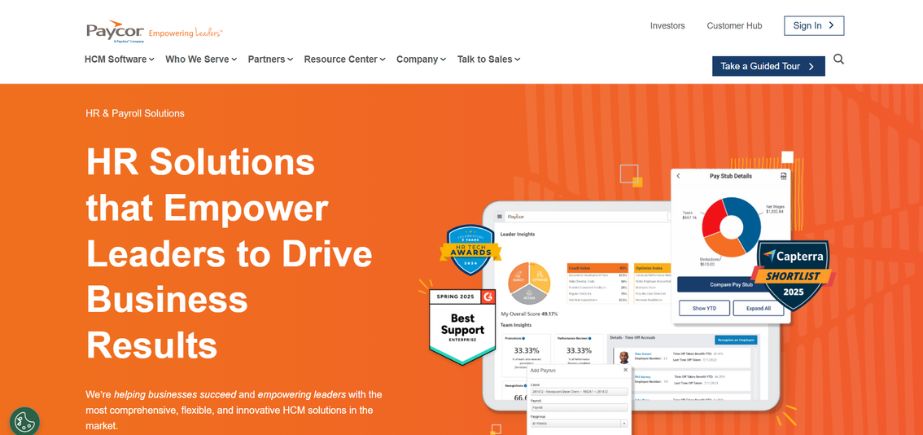
Type: Enterprise HR Management System
Rating: 4.9/5
Website: https://www.paycor.com/
Many large organizations rely on Paycor for all their workforce management requirements. With its strong capacity, the platform guarantees smooth operation for corporations that have an expansive employee base grouped by complex organizational structures. What stands out most in the software is its advanced notification system, which ensures everyone is updated immediately on important deadlines, changes in policies, and major announcements.
With Paycor, employees can take charge of their schedules, and their job sites will always have sufficient staff and match labor guidelines. With the platform’s surveys, organizations can learn what their employees think and how satisfied they are. The company is best known for dealing with complex situations related to payroll, benefits, and compliance among larger organizations. Through tracking and high-quality reports, the software enables HR professionals to solve problems and plan for organizational growth.
Key Features:
- Real-time notification system
- Employee self-scheduling tools
- Advanced survey capabilities
- Complex payroll management
- Enterprise-level compliance tools
Pros:
- Excellent for large organizations
- Comprehensive compliance features
- Advanced scheduling capabilities
Cons:
- Requires custom pricing
- Complex initial setup
- Overwhelming for small businesses
Pricing: Custom Pricing
3. BambooHR

Type: Human Resources Information System
Rating: 4.6/5
Website: https://www.bamboohr.com/
BambooHR is considered the top solution for companies focused on employee satisfaction and engagement. This modern platform brings together old and new HR tools to help improve how employees feel about their time with the company. BambooHR’s system allows businesses to store employee information, reviews, and other data securely and in a way that is quick to access. Time tracking within the software links automatically to payroll, ensuring all compensation is right and providing information on how productive each person’s work is.
Staying involved with employees is possible for organizations using BambooHR, thanks to pulse surveys, ways to give feedback, and performance reviews. Because the platform is straightforward, HR professionals and employees can both use it, which helps improve transparency and interaction in the organization. The system’s ability to generate reports reveals important trends about the workforce and helps pinpoint places where workers might be less satisfied or likely to stay.
Key Features:
- Comprehensive employee records management
- Integrated time tracking
- Advanced satisfaction measurement tools
- Seamless payroll integration
- Performance review systems
Pros:
- Focus on employee satisfaction
- User-friendly interface design
- Strong reporting capabilities
Cons:
- Limited customization options
- Pricing not transparent
- Basic project management features
Pricing: Custom Pricing
4. Workday
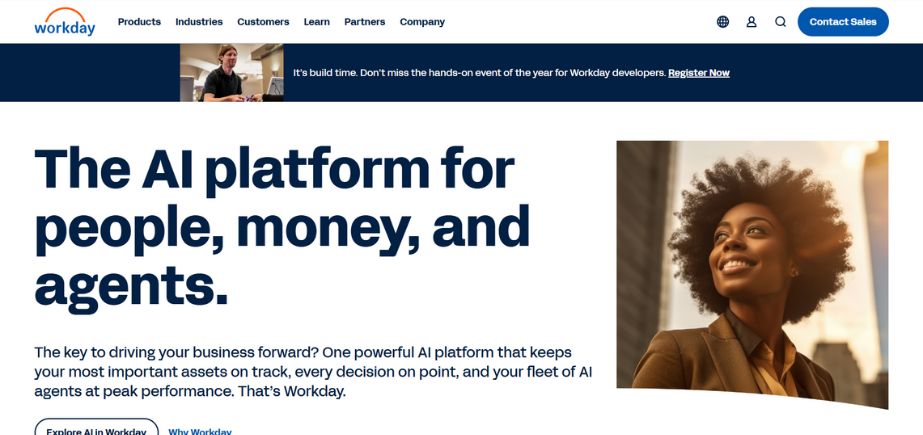
Type: Enterprise Cloud-based HR Platform
Rating: 4.6/5
Website: https://www.workday.com/
Workday is the ideal system for managing global workforces, designed for companies that work across many locations and countries. This advanced platform stands out in handling various employees scattered across various nations, monetary systems, and regulatory systems. Workday keeps track of multi-currency, country tax, and compliance requirements for complex payroll globally. Thanks to its time zone and working pattern support, this software is great for running operations across different countries.
Using the system, managers can follow both the various types of leave and the related rules set by each jurisdiction. The platform helps companies by giving them a comprehensive look at their worldwide staff through common reporting and analysis. Workday can smoothly connect with other enterprise tools, which makes it easy for businesses to operate efficiently.
Key Features:
- Multi-currency payroll processing
- Global scheduling capabilities
- International absence management
- Cross-border compliance tools
- Unified global reporting
Pros:
- Excellent for global operations
- Strong compliance features
- Comprehensive reporting tools
Cons:
- Complex implementation process
- High cost investment
- Requires significant training
Pricing: $34 to $42 per employee per month
5. Rippling

Type: All-in-One Business Management Platform
Rating: 4.5/5
Website: https://www.rippling.com/
Rippling brings together HR, IT, and finance operations into a single unified tool for business management. With this technique, enterprises no longer have to use various software that eases their work and makes operations more efficient. Rippling offers all the tools needed for managing workers, paying them, handling benefits, and tracking important compliance rules. On the platform, IT administrators focus on delivering devices, installing software licenses and security, while the finance tools are in charge of budgeting, connecting with the account team, and preparing reports.
With Rippling, companies can use reliable learning management tools to monitor how their employees are improving their skills. With this software, tedious activities across the three departments are handled automatically, lowering the admin workload a lot. Because of its approach, Rippling ensures that changes in different areas are reflected in every connected application. That’s why Rippling is valuable for organizations that want flexible management for various business functions as they grow.
Key Features:
- Integrated HR-IT-Finance platform
- Comprehensive training management
- Advanced automation capabilities
- Device and software management
- Unified employee experience
Pros:
- All-in-one platform approach
- Strong training capabilities
- Excellent automation features
Cons:
- No free trial
- Complex pricing structure
- Steep learning curve
Pricing: Custom Pricing
Suggested Blog: Best Employee Engagement Tools
6. Zenefits
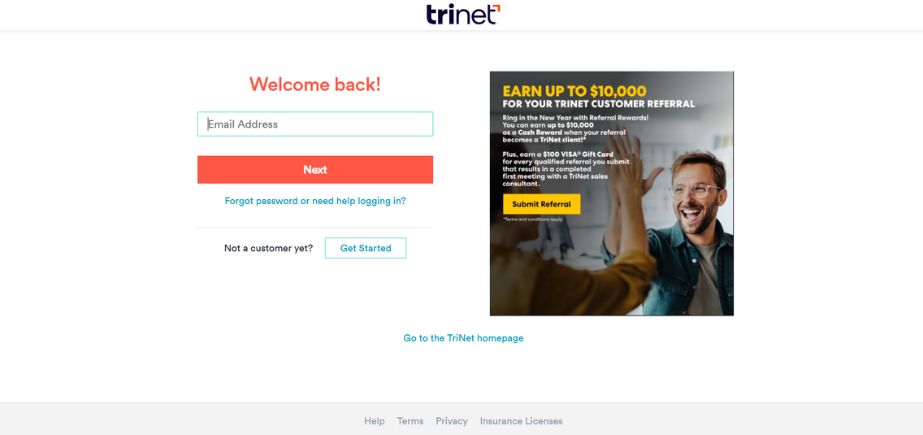
Type: Cloud-based HR Management System
Rating: 4.5/5
Website: https://www.trinet.com/ (Zenefits is now a part of Trinet)
Great goal management functions and seamless onboarding processes are what make Zenefits stand out. The platform takes care of the entire employee process, from finding the right people to making their retirement smooth, but it excels in handling performance and objectives. With Zenefits, both managers and employees can use scheduling tools that fit different ways of working and different shift patterns. With this system, employees can track their leave, as working holidays are automatically processed and rules are followed.
Automating onboarding with Zenefits results in every new hire going through the same process and makes life easier for the HR team. Thanks to the platform’s goal management, organizations can manage, observe, and assess employee objectives across all structures. With Zenefits, HR managers can gain insights into how productive the team is, how happy and engaged employees feel, and how well the company reaches its goals.
Key Features:
- Advanced goal management system
- Automated onboarding workflows
- Flexible scheduling tools
- Comprehensive time-off tracking
- Performance evaluation systems
Pros:
- Excellent goal management
- Automated onboarding processes
- Strong scheduling features
Cons:
- Limited customization options
- Basic reporting capabilities
- Annual billing requirement
Pricing: Custom Pricing
7. ClickUp
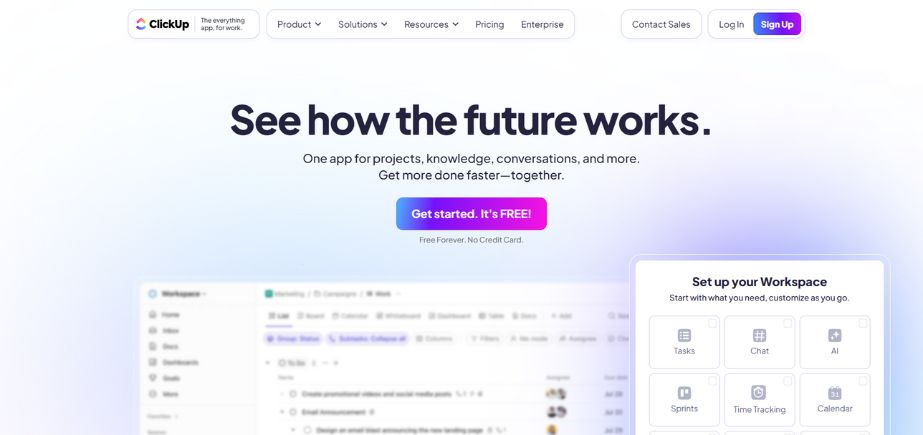
Type: Project Management and HR Platform
Rating: 4.5/5
Website: https://clickup.com/
ClickUp provides more flexibility than other employee management programs when forming tailored HR methods. This platform works great for organizations that must handle both project management and human resource tasks. ClickUp’s predefined templates help you quickly start new tasks such as onboarding, performance reviews, and training sessions. Fadepartnerware allows businesses to make their own fields, processes, and dashboards that fit what works for them and their company culture.
Project management tasks on ClickUp allow both human resources and company operations to work effectively, giving a full overview of team and project results. Thanks to the platform’s collaboration features, HR teams, managers, and employees can talk freely and work in an organized way. With ClickUp, users can create custom reports to guide important choices about staff management.
Key Features:
- Highly flexible customization options
- Comprehensive prebuilt templates
- Integrated project management
- Advanced collaboration tools
- Custom reporting capabilities
Pros:
- Highly customizable platform
- Strong project integration
- Excellent template library
Cons:
- Complex setup process
- Overwhelming feature set
- No free trial
Pricing: Free plan available
8. UKG Pro
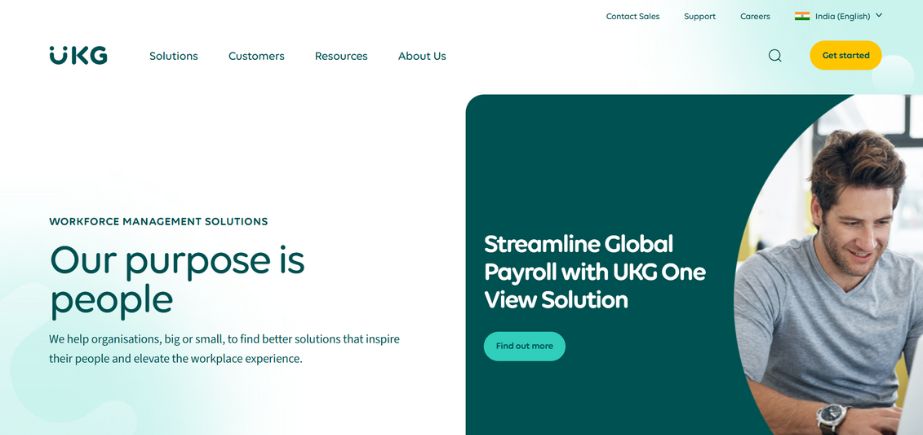
Type: AI-Enhanced HR Management Platform
Rating: 4.3/5
Website: https://www.ukg.in/
UKG Pro uses artificial intelligence to give unique workforce analysis and management advantages compared to other employee management software. This advanced platform is excellent at helping companies balance work and life, and in turn, organizations offer workers environments that increase their morale and productivity.
With AI, UKG Pro helps organizations predict what will happen in the workforce, notice problems coming, and improve employee staffing. Because of the software’s live productivity analytics, managers can easily see how each employee is performing and provide quick help where needed. The grouping tool from UKG Pro makes it possible for organizations to rearrange teams and supervisors to fit new business requirements.
The main advantage of the platform is that it examines a company’s workforce and provides practical recommendations for both employee involvement and better operations. Using UKG Pro, companies can report on various aspects and rely on the data to form smart plans for investing in their workforce.
Key Features:
- AI-powered productivity analytics
- Custom employee grouping
- Real-time performance monitoring
- Predictive workforce analytics
- Life-work balance tools
Pros:
- Advanced AI integrations
- Comprehensive analytics capabilities
- Strong productivity monitoring
Cons:
- No free trial
- Complex pricing structure
- Requires significant training
Pricing: $27 to $37
9. ADP Workforce Now

Type: Comprehensive HR and Payroll Platform
Rating: 4.1/5
Website: https://www.adp.com/
As it helps with new hire and performance onboarding, ADP Workforce Now appeals most to companies that value talent retention and growth. This long-standing platform draws on many years of experience in HR to supply complete solutions for every step of the workforce lifecycle. ADP’s onboarding process ensures every new hire follows the same guidelines, remains compliant, and understands all their obligations.
Tracking employee development in the software makes it easy to monitor learning, gain new skills, and succeed in their jobs, while also supporting important company aims. Thanks to ADP’s reporting system, employers can see detailed information on their employees and plan informed changes from that data. Through surveys, the platform gets feedback from staff at different parts of their careers, so organizations can gauge how engaged their teams are and find ways to improve. Because of its connections with other business systems, ADP can fulfill many of the needs of complex organizations.
Key Features:
- Comprehensive onboarding workflows
- Employee development tracking
- Custom reporting tools
- Advanced survey capabilities
- Extensive integration options
Pros:
- Excellent onboarding processes
- Strong development tracking
- Comprehensive reporting features
Cons:
- No free trial
- Complex pricing structure
- Limited customization options
Pricing: Custom Pricing
10. Sage HR
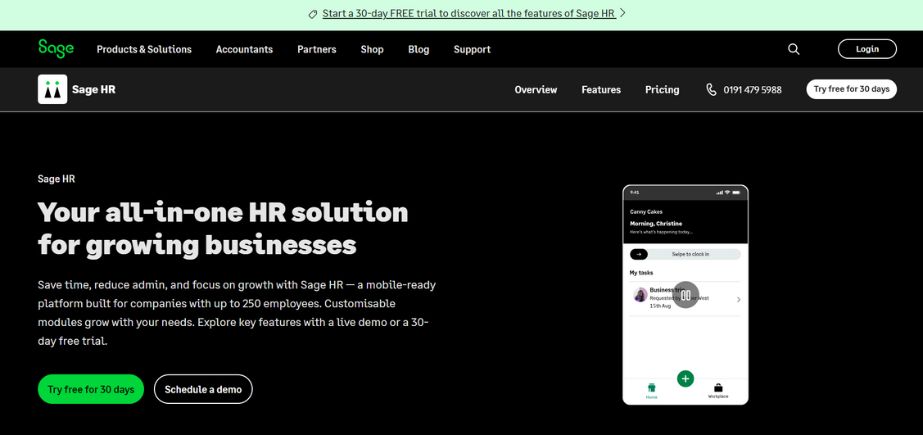
Type: Cloud-based HR Management System
Rating: 4.0/5
Website: https://www.sage.com/en-gb/
The strong mix of useful features and low costs means Sage HR is appealing to small and mid-sized businesses looking for good workforce management support. It is not needed to be a programmer—admins at organizations can create tailored processes on this platform with little effort. Sage HR makes it possible to create employee fields that are tailored to a company’s needs and the unique standards of its field.
The calendar feature allows everyone to see their shift schedules and avoid clashes at the time when staff are needed the most. Because Sage HR is simple and easy to use, organizations that don’t have much IT support or HR experience can pick it up fast. User reports give you practical insights into the team’s accomplishments without confusing people with too many details. Using these integrations, Sage HR allows businesses to link with major business tools, helping build an efficient technological system that still proves economical.
Key Features:
- Custom workflow builder
- Flexible employee field customization
- Shared vacation calendar
- Essential reporting tools
- Budget-friendly pricing
Pros:
- Cost-effective solution
- Easy-to-use interface
- Good customization options
Cons:
- Limited advanced features
- Basic reporting capabilities
- Fewer integration options
Pricing: £4.60 per employee/month
Conclusion
In 2025, organizations will have more opportunities than ever to improve their employee management methods using software. They have developed past simply processing payroll and now address many parts of an employee’s journey with a company. Every aspect, from hiring and starting work to performance and retirement, is handled better and more efficiently with today’s software tools.
Organizational needs, the amount of money available, and strategic objectives for the future should all be considered before picking an employee management system. Each highlighted platform in this guide is ranked among the top due to its strengths that cater to different business challenges. No matter if your organization wants to focus on customization, operate internationally, make employees happy, or save money, a solution can be found.
Frequently Asked Questions
1. What is the average cost of employee management software in 2025?
Prices for employee management software are very different depending on features, how large the company is, and how the system is implemented. Simple solutions range from $3-8 monthly per employee, while top-level tools can cost $15-50 or even more each month.
2. How long does it typically take to implement employee management software?
It can take a longer or shorter time to implement systems depending on the system’s features and the company’s size. Solutions built on the cloud can be set up within a couple of weeks, whereas complete enterprise systems often take 3-6 months.
3. Can employee management software integrate with existing business systems?
Today’s employee management software is designed to easily integrate with popular tools for accounting, project management, communication, and productivity.
4. What security measures should I look for in employee management software?
Important security elements are encryption of data on the way and at rest, as well as authentication with more than one factor, controls for user access, audit logs, and certifications such as SOC 2, GDPR, and HIPAA. Systems offered in the cloud must have secure data centers, frequent backups and able to recover data following incidents.
5. How do I ensure employee adoption of new management software?
Good adoption requires management of changes, helps the team recognize the benefits, provides thorough training, and continues to help throughout the process. Gaining input from workers during selection, picking systems that are easy to use, and telling them what they will gain from using the software make acceptance more likely.

